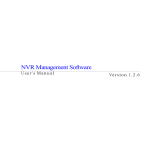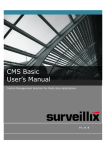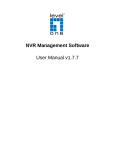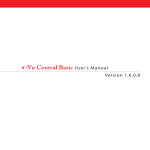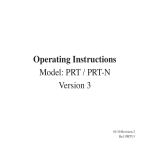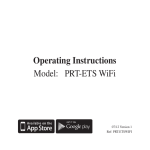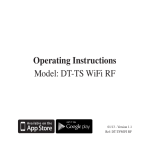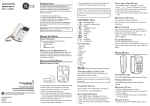Download Operating Instructions
Transcript
Operating Instructions Model : PRT-E / PRT-EN Installer Note: This thermostat is a combination model allowing you to choose if you require “Floor Only” or “Air & Floor” temperature control. Please see page 11 for more information. This product should be installed by a qualified electrican. Improper installation may result in injury, death or property damage. Contents Table Contents What is a programmable thermostat Installation Initial Setup Procedure Symbols Explained Button Layout Temperature Display Setting the Clock Temperature Override Frost Mode Setting the Comfort Levels Keylock Viewing the Floor Temperature Wiring PRT-E Wiring Diagram PRT-EN Wiring Diagram 1 2-4 5-6 7-12 13 14 15 15 16 16 17-18 19 19 20 21 What is a programmable room thermostat ? A programmable room thermostat is both a programmer and a room thermostat. A programmer allows you to set On and "Off time periods to suit your own lifestyle. A room thermostat works by sensing the air temperature, switching on the heating when the air temperature falls below the thermostat setting, and switching it off once this set temperature has been reached. So, a programmable room thermostat lets you choose what times you want the heating to be on, and what temperature it should reach while it is on. It will allow you to select different temperatures in your home at different times of the day (and days of the week) to meet your particular needs. Turning a programmable room thermostat to a higher setting will not make the room heat up any faster. How quickly the room heats up depends on the design of the heating system, for example, the size of the boiler and radiators. Neither does the setting effect how quickly the room cools down. Turning a programmable room thermostat to a lower setting will result in the room being controlled at a lower temperature, and saves energy. 2 The way to set and use your programmable room thermostat is to find the lowest temperature settings that you are comfortable with and the different times you have chosen and then leave it alone to do its job. The best way to do this is to set low temperatures first, say 18ºC, and then turn them up by one degree each day until you are comfortable with the temperatures. You wont have to adjust the thermostat further. Any adjustment above these setting will waste energy and cost you more money. If your heating system is a boiler with radiators, there will usually be only one programmable room thermostat to control the whole house. But you can have different temperatures in individual rooms by installing thermostatic radiator valves (TRVs) on individual radiators. If you dont have TRVs, you should choose a temperature that is reasonable for the whole house. If you do have TRVs, you can choose a slightly higher setting to make sure that even the coldest room is comfortable, then prevent any overheating in other rooms by adjusting the TRVs. The time on the programmer must be correct. Some types have to be adjusted in spring and Autumn at the change between Greenwich Mean Time and British Summer Time. 3 You may be able to temporarily adjust the heating programme, for example “Override”, “Advance” or “Boost” These are explained in the manufacturers instructions. Programmable room thermostats need a free flow of air to sense the temperature, so they must not be covered by curtains or blocked by furniture. Nearby electic fires, televisions, wall or table lamps may prevent the thermostat from working properly. 4 Installation Procedure DO`s 1.Do Mount the thermostat should be mounted at eye level. 2.Do read the instructions fully so that you best from our product. 3.Do install the floor probe into a conduit so that it can be replaced if necessary. DON’T`s 1.Do not install near a direct heat source as this will effect the workings of the thermostat. 2.Do not push hard on the LCD otherwise youwill damage the liquid crystal display and this is not repairable. Installation The thermostat is designed to be flush mount, a back box of 35mm should have been sunk in the wall prior to installation. Step 1 Carefully separate the front half of the thermostat from the back plate by placing a small flat head terminal driver in to the slots on the bottom face of the thermostat. 5 Step 2 Carefully unplug the ribbon connector which is plugged in to the front half of the thermostat. Place the thermostat front half somewhere safe. Terminate the thermostat as shown in the diagrams at the back of this booklet. Screw the thermostat back plate on to the back box Step 3 Re-connect the thermostat ribbon cable and clip the two halves together. Step 4 Turn on the power to the thermostat and allow the thermostat to stabilise for 1 hour before calibrating. 6 . How To Setup Your Thermostat This thermostat has many options available to you. Once you have set these settings you can leave them. They will be stored in the thermostat memory and do not need to be adjusted later. You need to use the table opposite as a reference guide when initially setting up the thermostat. We strongly suggest you read the next few pages so that you fully understand the features available and the intended use. You should also understand that by enabling one feature, another feature maybe made unavailable. This is because the feature is not available in that mode. Please read the features now, and then follow the setup routine on the following pages. 7 Feature Description Setting 01 Temperature Format 00=°C 01=°F (°C Default) 02 Switching Differential 01=1°C/F, 02=2°C/F, 03=3°C/F (01 = Default) 03 Temperature Calibrate 04 Frost Mode 05 Frost Protection Temp 07-17°C (12°C Default) 06 Output Delay Enter Value 00 - 30 minutes 00=Default 07 Comms # (PRT-EN) Enter number 01-32 08 Optimum Start (Preheat) 00=Disabled (Default) 01=01 hr 02=02 hr 03=03 hr 09 Rate of Change For information only, 10 Air Sensor Selection 00=Internal(Default) 01=Remote 11 Floor Sensor (Mode 1) 00=Disabled 01 Enabled 12 13 14 Floor Limit (Mode 1) Not Used Floor or Air&Floor Mode (Mode 00) | (Mode 01) 20-45°C (28°C Default) Enter Value 00=Disabled 01=Enabled (01 = Default) Floor Sensor Only = 00 Air & Floor Sensor = 01 Default Understanding the Features The installer should read the following features and then setup the thermostat accordingy to the features required. Temperature Format: Select between°C or °F Switching Differential: This is the number of degrees the heating switches back on below the set temperature. Temperature Calibrate: The thermostat is calibrated from the factory, but you can use this function to calibrate if required. Frost Mode: You can set whether the thermostat will maintain the frost temperature even when the thermostat has been turned off with the power button. As a default, this is enabled. Frost Protection Temperature: This is used to set the required frost temperature. The range is 07 - 17°C Output Delay: To prevent rapid switching, an output delay can be entered. This can be from 00 - 30 minutes. 9 Understanding the Features (Cont) Optimum Start: Optimum start will delay the start up of the heating system to the latest possible moment, to avoid unnecessary heating, so that the dwelling is comfortably warm by the programmed time. Rate of Change: This setting is calculated by the thermostat. Air Sensor Selection: (Mode 01 Only, See Page) You can select whether the air sensor used is the one built in to the thermostat or a remoteair probe. Floor Limit Sensor (In mode 01 Only, See Page ) The floor sensor is used to protect the floor surface. During normal operation, the thermostat will maintain the air temperature from the room sensor, but should the floor temperature limit be exceeded the heating will turn off. This setting allows you to enable / disable the floor limit function. Floor Temperature Limt: 20-45°C (Mode 01 Only, See Page ) 10 Understanding the Features Mode The PRT-E has two modes available. 00 = Floor Only. In this mode a single remote floor sensor is used to maintain a desired floor temperature. The programmed settings relate to the floor temperature only. Air temperature is not monitored in this mode. 01 = Air & Floor. In this mode, two sensors are used. The programmed settings relate to the air temperature and the floor sensor is used only to prevent the floor surface from overheating. A floor limiting temperature can be programmed in this mode, and should this temperature be exceeded, the heating will be switched off - even if the desired air temperature has not be achieved. 11 Setting up the Features: With the PRT-E turned off, press for 3 seconds On the LCD you will see 01(small) to the top right, and 00 (large) in the centre. Small setting = Feature # Large setting = Setting • Use the Up/Down arrow key to change the setting. • Press to accept and proceed to the next feature. 12 LCD Symbols Clock Indicator Heat Active Indicator Frost Mode On Floor Temperature Over Limit KeyLock On Flashing Optimum Start Mode Active 13 3. Button Layout Infrared Receiver H On/Off Button Clock Button A H Button A Button 14 Down Button Up Button Temperature Display Room Temp = Current room temperature Floor Temp = Current floor temperature (Displayed in Mode 0) SET = Displayed when you are adjusting the temperature setting. Setting the Clock To set the clock within the PRT-E, follow the steps below. • With the thermostat turned on, press twice • You are now able to set the minutes using the up/down keys • Press H to accept • You are now able to set the hours using the up/down keys • Press H to accept • You are now able to set the day of the week using the up/down keys • Press A to store and exit The clock is now set. The PRT-E has a battery which maintains the clock on a power failure. All program settings are retained in flash memory for 10 years. 15 Temperature Override Using the Up/Down arrow keys you can adjust the current set temperature. On the screen, you will see SET and the new temperature displayed. This temperature will be maintained until the next programmed comfort level. Press A to accept and exit. Frost Mode By pressing the “H” button, the thermostat will switch into frost protection mode. You will see on screen. The frost protection temperature will now be maintained. To cancel press H. To change the frost temperature setting, see page 8 16 Setting the Comfort Levels The PRT-E has 4 comfort levels for the weekday and 4 for the weekend. This method of control is not to have on/off times but to allow the occupant to set varying temperatures throughout the day. For example; 08.00 - 21°C (Wake) 09.30 - 16°C (Go to work) 16.30 - 22°C (Return home) 23.00 - 17°C (Sleep) If you only want to use 2 levels, you should program the unused levels to --.-You are now able to program the first comfort level for the weekday. Follow these steps; • To begin programming the comfort levels, press once. You will see Mo - Fr displayed. • Use the Up/Down arrow keys to select the time for the 1st comfort level for the weekday. • Press H to accept • Enter the required temperature for the 1st comfort level. • Repeat for comfort levels 2-4. • You will now see Sa Su on the screen. Repeat for the comfort levels for the weekend. • Press A to store and exit . Enabling Keylock The PRT-E has a keylock facility. To enable this press the “A” and “Down” arrow key for 10 seconds. When the keylock function has been activated, you will see on screen. To cancel, repeat the steps above. Viewing The Current Floor Temperature (Mode 01 Only) When set to Air & Floor mode, you can select to view the floor temperature at anytime. Press the “A” button for 3 seconds, the floor temperature will be displayed. After 30 seconds the display will return to show the “Room Temperature”. To return to the room temperature display, press H. 19 Heatmiser PRT-E Wiring N.B. USE SCREENED CABLE WE RECOMMEND BELDON 8451 FOR REMOTE SENSOR CABLING Switching: 16A MAX PRT-R2 Remote Sensors Extendable to R T1 - RT2 L N HEATIN G CIRC UIT REMO TE FL OOR S ENS OR RE MOTE A IR S ENSO R (IF SELECTED) 20 Heatmiser PRT-EN Wiring PRT-N Use screened cable for communications. + A 1 A2 COMMS CABLE 12V dc Remote Sensors Extendable to 20 meters YELLOW (A) BLUE ( B) REM OT E SE N SO R (IF S EL EC T ED) R EM O T E FL OOR SE N SO R























